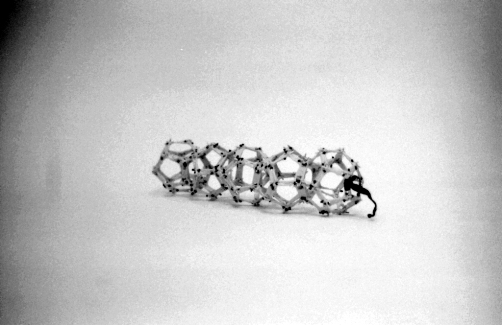The pieces which belong to his repertory are all made of building foam, a product from the do-it-yourself shops, to fill holes and cracks in buildings. This material comes out of a spay can like whipped cream, blows up and hardens in the form to which it is applied. Maybe it has longevity; we do not know yet. We only experienced that it gets a yellowish colour when exposed to light.
Building foam can be sprayed in many ways. One can make layers, textures, dollops, parallel lines and concentric circles with it, and the artist uses all these procedures. In this way he makes irregular textures and large dollops, but he also writes characters and builds three-dimensional objects with it. The reliefs and sculptures he makes with this material are very accessible at first sight, because the procedures stay visible, and the sculptures most of the time have something in common with things in our everyday surroudings. They look like frayed tapestries and bathing-mats, lace tablecloths and embroidery, but enlarged and made from a strange, blown up material.
Yet Jan Bokma wants to show his public also something else with his sculptures. Therefore he accompanies his works with roughly sawn signs with ‘information’ for the public. The texts, in an irregular handwriting, are painted in black on a smudged yellowish ground; they indicate that the public has to see the works as ‘art’. Sometimes the context of the museum is emphasized, than again a period of art history or a style, like the renaissance or abstract expressionism, is pointed to, but there is also commentary when it is asserted that a work is a failure. The signs can indicate that a work has no title or no meaning and therefore no reason to exist. There is also a sign which says that the work ‘speaks for itself’, a stereotype in art criticism.
The yellowish signs are equivalents of the inconspicuous, white signs in a museum on which, in little and in a neat typeface, factual information is shown. Because the signs accompanying the works of Jan Bokma are too coarse, too big and in the wrong colour, their message reads as ironic commentary.
From his repertory of sculptures, together with the signs, the artist can choose to make installations and so each time build his own museum. The context of the museum fascinates him at this moment. In such a context each object can be seen as art and every articulation is going to refer to art. Art criticism is made possible by this institution and it also controls the careers of artists. Therefore Jan Bokma is interested in the pretence of being a classical sculptor who varies on traditions and conventions of the visual arts in the context of the museum. But his play is an ironic one. In stead of bronze he uses the banal material of the building foam, in stead of monuments he makes ‘bathing-mats’ and ‘cakes with whipped cream’. By this he creates little art-worlds in which he himself is lord and master over the forces of the institution.
- Katalin Herzog about Jan Bokma, May, 2007
